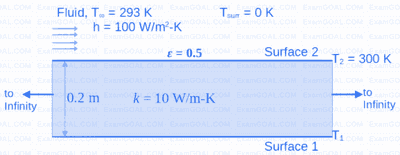1
GATE ME 2022 Set 1
Numerical
+2
-0
Consider a solid slab (thermal conductivity, k = 10 W∙m-1∙K-1) with thickness 0.2 m and of infinite extent in the other two directions as shown in the figure. Surface 2, at 300 K, is exposed to a fluid flow at a free stream temperature (T∞) of 293 K, with a convective heat transfer coefficient (h) of 100 W∙m-2∙K-1. Surface 2 is opaque, diffuse and gray with an emissivity (ε) of 0.5 and exchanges heat by radiation with very large surroundings at 0 K. Radiative heat transfer inside the solid slab is neglected. The Stefan-Boltzmann constant is 5.67 × 10-8 W∙m-2∙K-4. The temperature T1 of Surface 1 of the slab, under steady-state conditions, is _________ K (round off to the nearest integer).

Your input ____
2
GATE ME 2017 Set 1
Numerical
+2
-0
Heat is generated uniformly in a long solid cylindrical rod ( diameter $$ = 10\,\,mm$$) at the rate of $$4 \times {10^7}\,\,W/{m^3}.$$ The thermal conductivity of the rod material is $$25$$ $$W/m.K.$$ Under steady state conditions, the temperature difference between the center and the surface of the rod is ________________ $${}^ \circ C.$$
Your input ____
3
GATE ME 2015 Set 2
MCQ (Single Correct Answer)
+2
-0.6
A cylindrical uranium fuel rod of radius 5 mm in a nuclear reactor is generating heat at the rate of $$4 \times {10^7}\,\,W/{m^3}.$$ The rod is cooled by a liquid (convective heat transfer coefficient $$1000W/{m^2}$$-$$K$$) at
$${25^ \circ }C$$. At steady state, the surface temperature (in $$K$$) of the rod is
4
GATE ME 2015 Set 1
MCQ (Single Correct Answer)
+2
-0.6
A $$10$$ $$mm$$ diameter electrical conductor is covered by an insulation of $$2$$ $$mm$$ thickness. The conductivity of the insulation is $$0.08$$ $$W/m$$-$$K$$ and the convection coefficient at the insulation surface is $$10$$ $$W/{m^2}$$ -$$K.$$ Addition of further insulation of the same material will
Questions Asked from Marks 2
GATE ME 2025 (1) GATE ME 2024 (1) GATE ME 2022 Set 2 (1) GATE ME 2022 Set 1 (2) GATE ME 2017 Set 1 (1) GATE ME 2015 Set 2 (1) GATE ME 2015 Set 1 (1) GATE ME 2015 Set 3 (1) GATE ME 2014 Set 4 (1) GATE ME 2014 Set 2 (1) GATE ME 2014 Set 3 (1) GATE ME 2009 (1) GATE ME 2008 (2) GATE ME 2007 (3) GATE ME 2006 (2) GATE ME 2005 (1) GATE ME 2003 (2) GATE ME 1999 (1) GATE ME 1998 (1) GATE ME 1996 (1) GATE ME 1991 (1)
GATE ME Subjects
Engineering Mechanics
Machine Design
Strength of Materials
Heat Transfer
Production Engineering
Industrial Engineering
Turbo Machinery
Theory of Machines
Engineering Mathematics
Fluid Mechanics
Thermodynamics
General Aptitude